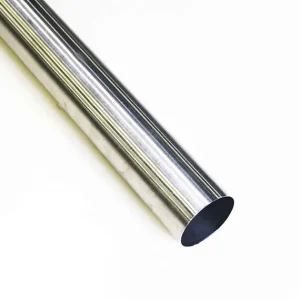440 stainless steel plate (most commonly 440C / AISI 440 series) is a high-carbon, martensitic stainless plate engineered for maximum hardness and wear resistance after heat treatment; it offers excellent edge retention and moderate corrosion resistance, making it ideal for wear parts, knife blades, bearings, valve components and precision tooling where hardness matters more than deep seawater corrosion resistance. For applications requiring higher toughness or superior corrosion behavior, duplex/ustenitic grades (e.g., 316) or high-toughness tool steels may be preferable.
What is 440 high-carbon stainless steel plate?
The "440" family are martensitic stainless steels with relatively high chromium (~16–18%) and varying carbon levels by subgrade (440A, 440B, 440C). Among them, 440C contains the highest carbon and is the most commonly specified when plate or bar needs maximum hardness and wear resistance after quench & temper. Martensitic stainless steels form martensite on cooling and can be hardened by heat treatment; they are not as corrosion-resistant as 300-series austenitics but outperform plain carbon steels for rust resistance in many environments.
Chemical composition — 440A / 440B / 440C
| Element | 440A (wt%) | 440B (wt%) | 440C (wt%) | Comment |
|---|---|---|---|---|
| C (Carbon) | 0.60–0.75 | 0.75–0.95 | 0.95–1.20 | Higher C → higher achievable hardness (440C highest). |
| Cr (Chromium) | 16.0–18.0 | 16.0–18.0 | 16.0–18.0 | Provides stainless characteristics and hardenability. |
| Mn (Manganese) | ≤1.0 | ≤1.0 | ≤1.0 | |
| Si (Silicon) | ≤1.0 | ≤1.0 | ≤1.0 | |
| P (Phosphorus) | ≤0.04 | ≤0.04 | ≤0.04 | Impurity limit |
| S (Sulfur) | ≤0.03 | ≤0.03 | ≤0.03 | Impurity limit |
| Mo (Molybdenum) | trace (varies) | trace | trace (up to 0.75%) | Some specs add Mo for toughness / hardenability. |
| Ni, N, V, others | small/trace | small/trace | small/trace | Minor additions in specific producer variants. |
(Values shown are typical ranges from technical datasheets — use supplier mill certificates for purchase acceptance).
Key material properties
| Property | Typical range / value | Notes & testing context |
|---|---|---|
| Tensile strength (UTS) | ~760 – 1970 MPa (depending on heat-treat). | Highly dependent on tempering temperature. |
| Yield strength | wide range (see supplier data) | Martensitic structure → high yield when hardened. |
| Hardness (HRC) | up to 58–64 HRC (peak for 440C when fully hardened). | Rockwell C values depend on tempering; 60 HRC commonly achievable. |
| Elongation | 2–14% (lower when fully hardened). | Ductility reduces with hardness. |
| Modulus of elasticity | ~200 GPa | Typical for most steels. |
| Thermal conductivity | ≈ 20–25 W/m·K | Useful for heat-treat & process planning. |
| Corrosion resistance | Moderate (better than carbon steels; inferior to 300-series). | Performs well in mildly corrosive environments; not for prolonged seawater without protection. |
Testing/QA tip: Request mill test certificates (chemical + mechanical) and request hardness checks across plate thickness if you need uniform performance.
Common specifications & cross-designations
-
AISI / SAE / UNS: AISI 440C ≈ UNS S44004.
-
EN / DIN: Commonly referenced as X105CrMo17 / 1.4125 in EN system.
-
ASTM: Stainless plate is often supplied to ASTM A240 / A480 classifications (stainless plate/sheet general standards) — buyers will specify 440C and required tests under these or equivalent commercial standards where appropriate. (Note: ASTM A240 is the common spec for stainless plate and sheet; manufacturer/certification details differ by application.)
Heat treatment, hardening & tempering
-
Annealing: Heat to ~843–871°C (1550–1600°F), then furnace cool to soften for machining.
-
Hardening (quench): Solution/normalize and then harden by heating to ~760–1010°C (1400–1850°F) depending on specific process and section thickness; oil or air quench per shop practice.
-
Tempering: Temper at targeted temperatures to reach desired HRC vs toughness tradeoff. Lower temper → higher hardness, less toughness; typical service temp depends on application (300–600°F / 150–320°C ranges common).
Note: 440C can achieve the highest hardness of the stainless grades when properly heat treated; however, plating, welding, or harsh machining requires annealed condition followed by final hardening at a central heat treat shop.
Fabrication, machining & welding notes
-
Machining: Best machined in annealed condition; carbide tooling and conservative feeds/pecks recommended when machining hard conditions.
-
Welding: Generally not recommended to weld 440C in hardened condition due to cracking and hardening; preheat and post-weld heat treatment required for critical joints. Use appropriate filler and energy control; for many applications, fabricate before final hardening.
-
Polishing & finishing: Polishes well; commonly used for blades and parts that require a fine surface.
Is 440 stainless better than D2?
It depends on the requirement. 440C offers better corrosion resistance (stainless) than D2 (a high-carbon, high-chromium tool steel but NOT stainless), while D2 often provides slightly better toughness and edge retention for some tooling uses due to higher carbide volume and different microstructure. For wet or food contact environments prefer 440C; for pure wear resistance where corrosion isn't a concern, D2 can be competitive.
| Property | 440C (stainless) | D2 (tool steel, semi-stainless) |
|---|---|---|
| Corrosion resistance | Good (stainless) | Poorer — semi-stainless; requires maintenance |
| Hardness (HRC) | 58–64 (when hardened) | 58–62 (heat treatment dependent) |
| Toughness | Moderate | Typically higher toughness / edge retention under some workloads |
| Typical uses | Blades, bearings, valve parts, precision wear parts | Dies, cutters, heavy wear tooling |
440 vs 304 vs 316 — how to choose
-
440: Choose when hardness/wear resistance and moderate corrosion resistance are priorities (e.g., cutting tools, bearings, valve seats).
-
304 / 316 (austenitic): Select for superior corrosion resistance, formability and weldability (food, pharma, marine for 316). They cannot be hardened substantially by quench/temper treat — different use case.
Use 316 where chloride resistance is essential (seaside exposure, chemical processing) and 440 where hardness and wear are essential. (See corrosion & mechanical tradeoffs in supplier datasheets.)
Sizes, thicknesses and plate weight (common specs + calculation)
Common plate sizes & thicknesses offered by stockists and mills:
-
Standard sheet panels: 1000×2000 mm, 1250×2500 mm, 1500×3000 mm (varies by mill).
-
Thickness range for plate supply: 0.5 mm up to 50 mm+ depending on mill; common industrial stock plates are 1.5 mm to 25 mm.
Weight calculation formula (steel):
Weight (kg) = Length (m) × Width (m) × Thickness (m) × Density (≈ 7.85 g/cm³ → 7850 kg/m³)
Example: 1.5 m × 3.0 m × 10 mm (0.01 m) → 1.5 × 3.0 × 0.01 × 7850 ≈ 353.25 kg.
Typical applications
-
Precision cutting blades and kitchen knife blanks (440C popular).
-
Bearings, valve parts, bushings that need wear resistance.
-
Pump shafts and small mechanical components where heat treatment to high hardness is required.
-
Wear plates, small tooling, and some surgical/medical instruments where polishing and moderate corrosion resistance are needed.
2025 price comparison — USA / Europe / China
Important: steel and specialty alloy prices fluctuate daily and vary with form (coil vs plate), thickness, finish, order quantity and trade measures. The figures below are representative market snapshots from suppliers and marketplace price lists (April–Aug 2025 sampling) to help procurement planning. Always request firm quotes and MTC (mill test certificates).
Representative price ranges (440 / 440C stainless plate) — 2025 (indicative)
| Region | Representative price (USD) | Source notes |
|---|---|---|
| USA (distributor/retailer) | US$1.50–3.50 / kg (approx. US$1,500–3,500 / tonne for plate/sheet retail/distributor prices) | Online metals & distributor listings show per-piece pricing; specialty plate costs higher. |
| Europe (wholesale/distributor) | US$1.6–3.2 / kg (regional variation; tariffs & freight affect landed price) | Market indexes and EU distributors report regional ranges. |
| China (mill/trading) | US$1.30–2.50 / kg (mill/trade prices often lower for domestic buyers; export quotes depend on anti-dumping duties and tariffs) | China supplier listings give a wide range (some low per-ton listings, but watch MOQ and trade measures). Also note China anti-dumping duties on certain stainless plate imports (June 2025 government notice). |
How to interpret these ranges:
-
Lower numbers reflect bulk mill coil/plate domestic trades; higher numbers reflect small-quantity distributor/retail prices, premachining, or high finish/flatness.
-
Specialty finishes, tighter thickness tolerances, and certifications (NACE, AMS, API etc.) add cost.
-
Price volatility and trade restrictions (anti-dumping duties) materially affect landed cost to each region. Always obtain current quotes and include freight, duty and packaging.
Standards, testing and quality control
When ordering 440 plate for critical parts, require:
-
Mill Test Certificate (MTC) to EN 10204 (3.1) or equivalent.
-
Hardness profile tests (Rockwell) and mechanical test reports (UTS, yield, elongation).
-
Positive material identification (PMI) or spectral analysis report.
-
Non-destructive tests (as required): UT, dye penetrant, or surface finish report.
-
Traceability to batch / heat number & production date.
These items raise the technical credibility of a supply and satisfy many EEAT expectations for industrial procurement.
Why source 440 stainless plate from MWalloys
MWalloys is a China-based specialty steel manufacturer and mill-grade stockist focused on stainless and tool-grade plates. Key buyer advantages:
-
Factory direct pricing: We offer 100% factory EXW pricing for large orders — fewer intermediaries and cost advantage for bulk procurement.
-
Stock availability & fast delivery: MWalloys maintains common 440 plate thicknesses in stock; typical stock lead times (for standard sizes) are short — days to 2 weeks depending on quantity and finish.
-
Custom processing: Cut-to-size, heat-treat to spec, surface finishing and machining available before shipment.
-
Certificates: We supply EN / ASTM MTCs and chemical/mechanical test reports on request.
If you’d like, I can prepare an EXW price sheet from MWalloys for your most common plate sizes (please provide thickness, dimensions, and approximate quantities).
Frequently Asked Questions (FAQs)
1: Is 440C stainless suitable for marine environments?
440C has moderate corrosion resistance, better than plain carbon steels but inferior to 316 stainless. For continuous seawater exposure, 316 or duplex stainless steels are preferred; 440C can be used in splash or intermittently wet environments if rinsed and maintained.
2: Can 440 plate be welded?
Welding 440C is difficult in hardened state; preheat, controlled welding procedures, and post-weld heat treatment are required for critical parts. Best practice is to fabricate in the annealed condition, then perform final hardening/tempering.
3: What hardness can I expect from 440C plate?
When properly quenched and tempered, up to ~60 HRC or slightly higher is achievable. Hardness depends on section thickness, exact chemistry, and heat-treat cycle.
4: Are there standardized plate grades for 440 in EN/DIN?
Yes! X105CrMo17 / 1.4125 is the commonly used EN/DIN designation for AISI 440C equivalents. Always reference both AISI and EN designations in POs for clarity.
5: Which is better for knives: 440C or D2?
For corrosion resistance and ease of maintenance, 440C is better. For tougher cutting tasks and longer edge retention in dry conditions, D2 often performs better. The choice depends on environment and sharpening preferences.
6: Can 440 be hardened through the full thickness of thick plates?
Deep hardening depends on carbon, chromium and section thickness. Very thick plates may not harden uniformly; consult heat-treat provider and specify required hardness profiles.
7: Is 440 magnetic?
Yes, 440 is martensitic and thus magnetic, unlike austenitic 300-series stainless steels.
8: What surface finishes are typical for 440 plate?
No.1 (hot rolled), 2B cold-rolled, bright, and polished finishes are available depending on mill processing and subsequent polishing operations. Specify finish in PO.
9: Do you provide small-quantity orders?
Yes. MWalloys supplies both mill packs and smaller distributor quantities; small-batch pricing will reflect additional handling/processing costs.
10: What certifications are available from MWalloys?
Typical deliverables: EN 10204 (3.1) MTC chemical & mechanical reports, PMI / spectral analysis and hardness records. Additional tests (e.g., NACE) can be arranged on request.





